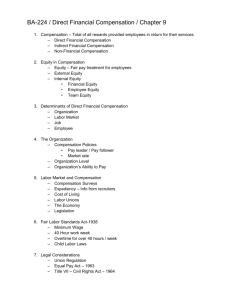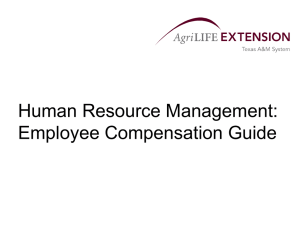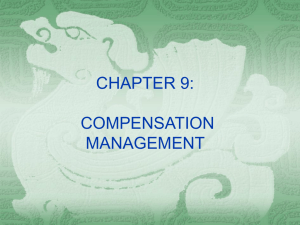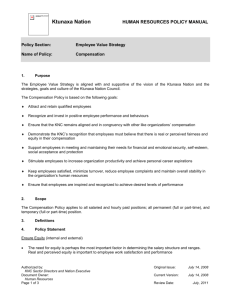Compensation and Benefits - DeGroote School of Business
advertisement
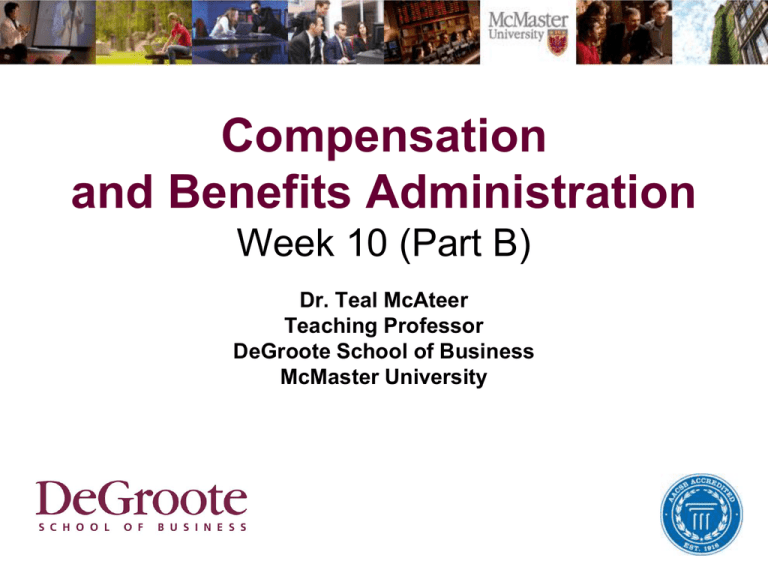
Compensation and Benefits Administration Week 10 (Part B) Dr. Teal McAteer Teaching Professor DeGroote School of Business McMaster University Responsibilities of Compensation Professionals Legislative compliance Conduct pay or wage surveys Conduct job evaluations Create links between desired rewards and levels of performance Monitor compensation costs Pay Surveys Method of obtaining accurate information about pay rates for relevant jobs in other organizations Gauge of external equity How To Conduct A Pay Survey Specify the purpose of the survey Specify jobs to be surveyed, their descriptions or specifications, and the information needed from survey participants Select comparison employers for inclusion in the survey Select a survey method and design a survey instrument Administer the survey Analyze and communicate survey data Job Evaluation Systems Determine relative worth of jobs to the organization Internal equity Central to Pay Equity Job Evaluation Process Collect job analysis data Prepare job descriptions and job specifications Choose compensable factors – those factors an organization values and chooses to reward through differential pay Develop or choose a job evaluation method Evaluate jobs Pay Equity Job evaluation system must be compliant with Pay Equity which considers factors of Skill Effort Responsibility Working conditions System must be gender neutral Types of Job Evaluation Methods Ranking Level description (classification method) Factor comparison Point methods Market pricing Ranking Orders jobs from least valued to most valued More appropriate for small organizations and those with small numbers of jobs Advantages Simple Quick and inexpensive Disadvantages Entirely subjective No explicit rationale or documentation for results Level Description (Classification Method) Places jobs in a pre-existing hierarchy Compares jobs to descriptions of job grades Advantages Inexpensive Readily available Disadvantages Cumbersome Factor Comparison Compares jobs to key jobs on scales of compensable factors Advantages Custom-built Easy to use Disadvantages System becomes less accurate as key jobs change Complex Limited to manufacturing, manual, blue-collar jobs Point Method Jobs are compared to standardized descriptions of degrees of universal compensable factors and sub factors Advantages Most accurate Stable over time Disadvantages Administrative costs can be high Market Pricing Relies entirely on the labour market to determine how much jobs should be paid Advantages Avoids management bias Employees paid at market value Disadvantages Promotes instability of pay structure May lead to perceived inequities Results depend on organizations surveyed Difficult to obtain pay information about some of the less common jobs in an organization Key Outcome of Job Evaluation Hierarchy of jobs in terms of their relative value to the organization How Is Pay Assigned to Jobs? Requires pay philosophy decision regarding Relationship of pay levels to market Lead Lag Match Pay Policy Line Graphic depiction of line drawn between midpoints of salary ranges Represents an organization’s pay level How do Organizations Structure Pay? Typically offer range of pay Variations in pay based on different in performance, employee qualifications and/or seniority Requires rationale for setting starting pay and for progression through the range Jobs of similar value can be grouped into pay grades Within a pay grade, there is a pay range which defines the upper and lower limits of pay Assigning Pay to Persons Shift from job-based to person-based pay system Skill based pay systems Based on knowledge and skills individuals develop on the job Competency based pay systems Compensation is based on individual traits, attitude and/or behaviours individuals bring and apply to the job. Using Pay to Motivate Employees Pay for performance = pay is contingent on some level of performance specified by the organization Merit pay Hinging promotion to higher-paying jobs contingent of superior performance Incentive pay system Pay For Performance Systems Individual Group Company Merit Promotion Straight piece rate Group piece rate Group standard hour plans Profit sharing plans Cost savings plan Compensation Administration Ensure that compensation system is achieving its goals and that compensation costs remain within allocated amounts Mechanisms used include: Compa-ratio Budgets Periodic audits of wages Pay Equity Equal pay for work of equal value Pay Equity Plan is required for each bargaining unit and for that part of the establishment that is not in any bargaining unit Trend – Total Rewards Definition: Any type of reward for service/work More options now presented to compensate/reward employees. Desired effect is to enhance ability to attract, retain and motivate employees in a very competitive market (i.e. “War for Talent”) Total Rewards Model Work Experience Benefits Compensation Why Total Rewards Drive for profitability (private sector) Drive for improved effectiveness/efficiency Better control of labour costs Enhanced ability to recruit, attract and retain key staff Enhanced flexibility Categories Of Benefits Universal benefits Statutory benefits Discretionary benefits for employee protection Pay for time not worked Employee services Universal Benefits Government provided without requiring direct contributions from either employees or employers OAS (Old Age Security) GIS (Guaranteed Income Supplement) Provincial hospital and medical plans (OHIP) Statutory Benefits Employer must provide under federal and/or provincial laws CPP/QPP Workers’ compensation Employment insurance Supplementary coverage i.e. SUB plans Health insurance Discretionary Benefits Private pension plans Defined benefit plan Defined contribution plan Combination Group insurance programs Holiday And Vacation Pay Statutory plus others Vacations Employee Service Benefits Savings plans Tuition loans Recreation facilities and programs Parking privileges Flexible Benefits Flex plans allow employees a degree of choice in some of the benefits, with varying levels of cost-sharing by level of coverage, and an opportunity to review the choice on a periodic basis Four types Modular plans Core plus option plans Private health services plans Cafeteria plans Controlling Benefits Cost Provide benefits that the majority of employees value and eliminate those in which they have no interest Have employees contribute a certain amount toward the purchase of discretionary benefits Group insurance Managed care of employer-provided health benefits Issues In The Benefits Areas Pension issues Same-sex spousal benefits Controlling rising benefit costs Disability management New accounting methods Benefit Cost Containment Strategies Contribution changes Limits Coverage changes Drugs Proactive management approach Communication, education, incentives New Plan/programs The Work Experience Satisfy intrinsic needs Includes elements of reward that are important to employees and employers but are less tangible than compensation and benefits Employees place high value on the work experience Elements Of The Work Experience Acknowledgement and recognition Balance of work/life Culture Development Environment


